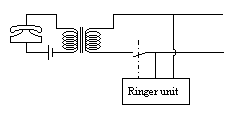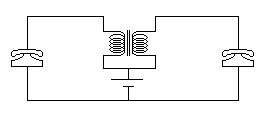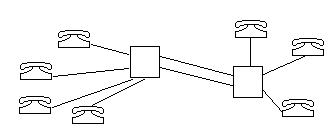

ON PHONES
By: MrPoyz
v0.1 VERY MUCH DRAFT
Introduction
Let me start by saying that since this document probably will be mostly read by an American audience, I'm probably not the man to write this. My experience with phones comes from the Swedish telco, and the Swedish army. There are a lot of things, mainly when it comes to interfacing with Ma' Bell, that I know little or nothing about. Understand though, that fixed line telephones has been around since late 19th century, and that on this level they all work on the same principles. If anyone feels like writing a piece about the specifics of interfacing with the US system, either standalone, or as an extension of this document, then that'd be much appreciated. Also, when reading this, please bear in mind that English isn't my first language. Any help with proofreading, or any comments and suggestions at all for that matter would be much appreciated. I can be reached at mrpoyz@hotmail.com
Work left to do
The Achilles heel of improvised telephones is the ringing mechanism. I'm still thinking about it, but all solutions I've managed to dream up are a bit more complicated than the rest of the circuits described here. If anyone has a good idea of how to generate about 60v AC at 20Hz, please drop me a line.
My grandfather used to say, "There are many ways to skin a pig". My answer the first time I heard it was "But, grandpa, one doesn't skin pigs, one boils and scrapes them...". Then he smiled at me and said "Yes, that's one way of doing it". It was a good lesson, I think. The same holds true for wiring telephones. I'm only going to cover what I think are the commonest most practical circuits, since I feel that it's better to keep this on a level where more people can appreciate it.
Local battery

Simplified local battery telephone.
This is the oldest of the circuits, and once upon a time it was the standard. As the name implies, there is a power source connected to each phone in the net (for lack of better words). This is the way standard battery operated military field phones work, (at least ours do), and it has several advantages:
The problem with this set-up is just that it requires a battery by each phone, which means that it isn't care free, in the sense of a modern phone system (for the subscriber, that is). Also, you can not use unmodified standard phones in a local battery net; an adapter needs to be built for each phone. Even so, if you want to build a more advanced telephone nets (incorporating manual switchboards or such), or if you need the range, or if you want to interface with military field-phones, this is the way to go.
Central-to-local adapter
Presumably there are two ways to enable a "normal", central battery phone to work in a local battery environment: one could either rebuild the phone, or construct an adapter. I'll concentrate on the adapter, because I think it is more flexible, and because it is an avenue that works for all (bold words, but it should...) phone models.

The battery is anything that delivers about 6 volt. Depending on phone model, 3 volt would suffice, and I've recommended 3 - 4.5 volt to people in the past, but there's no harm in a bit of a safety margin, maybe except the added bulk. I suggest four D-cells in series. The transformer is a 600 Ohm: 600 Ohm audio transformer, and it is there to keep the battery current loop local, while allowing the speech to propagate down the line. Unless you've figured out a way to generate a passable ringing signal, you can skip the rest, but I've drawn it in for completeness. The idea is that when you want to ring the other party, you send 60-90V of AC (20Hz is about right. By the way, the power-grid is at 50 or 60 Hz, depending on where you live, and that'd be too much. Also, the voltage is too high). The dash-dot line indicates that the switch is controlled by the ringer unit, and it is there so the ringer unit can prevent your own phone from ringing while you're trying to raise the other party.
In absence of a good simple ringer unit, someone on the Alpha board who's name I've forgotten but who should be given credit here recommended to keep the receivers off hook at all times and, when you want to call the other party, stick the receiver in a tin can and whistle hard. I haven't tried it myself, but it ought to work just fine. It won't cause the bell to ring, for obvious reasons, but it'll make a noise that can be heard. As the old man said: There are many ways to skin a pig.
Central battery
Modern telephones all use this technology. What it means is that the individual phones have no power source of their own. The main advantage is that the phones become maintenance free. In the old days it wasn't unheard of to have a central battery inside, for instance an office, and then convert to local-battery for the outgoing line. If you want to mess with it, you can do the same.
Improvised central battery

This is the simplest phone hook-up that I know of. Over moderately long distances it works well. The normal battery to use is a regular 9V, but if you need to push through a bit more line, then there is no reason why the voltage can't be increased. Building with much less voltage would give frustrating results, unless the battery is very fresh and the lines are kept short. If you try to push through too far, the needed voltage will eventually be ridiculous, and you'll spend more energy overcoming line resistance than powering phones. When that happens, it's time to go to a local battery system. For distances of a kilometer or so, with scrounged equipment it's one of the best. In theory, the sound quality should improve if one were to add a 0.47uF capacitor in parallel with the battery. I haven't tried it, but it's something to keep in mind.
A 'real' central battery

This set-up is more like the way the telco hooks up your phone. It has better range than the first circuit, but to draw on that advantage, you have to put the battery in the middle of the line, and that may or may not be convenient. The battery is typically a 6V lantern battery, and the transformer is a 600Ohm: 600Ohm audio transformer. You'll find that these get used for most anything around phones.
Lines
There isn't much to say about them. If you're buying new line ahead of time, then look not only at cost and color, but also at such things as cable strength and, if you plan to keep the lines operational for a long time, weather resistance of insulating material. If you want to mess with it, you could use bare wire, just like in the old days; for long distances that may be a bit cheaper. Then again, you'll have to spend money and time on rigging insulators for the wire to run on.
If you're improvising or scrounging, you'll have to take what there is (by definition), but there are a few things that aren't entirely obvious:
Improvised phone lines, like all other improvisation isn't a science. It's a state of mind.
Net layout
Some overlaps may exist, but I think there are three basic layouts to consider: Point to point, party line and star-shaped. Point to point is simply two phones connected to each other. It's the simplest layout, both for construction and for range estimation (see below.)
The second layout is a party line. What I mean by that is that we have an unknown number of phones connected in parallel.

This layout can work well unless there are too many people involved at the same time, in which case it's hard to maintain effective communications, simply because everyone babbles away at the same time. The party line can be built either using what I dubbed the real central battery, or using local battery. I think local battery is better, because the power draw on the battery will increase sharply when more phones are added, so you'll either need a big battery, or a sack-full of small ones. I don't even want to start to think about how to do range estimations in a set-up like this.
The third one (star-shaped) is the one that mimics a 'real' phone net most closely. All phones are given a separate line that is drawn to a central switching point. I won't go into how to build a proper switch, but if you're going to do it, I think you can save yourself some grief by trying to look at a real old-time manual switchboard. It's basically a bunch of 1/4" mono audio plugs and a grid of connectors. I've never seen the need for it, and after a brief, stressful stint of cross-training as a field switch operator many years ago I decided that I wasn't very well going to build one just to have it around for fun. The way the real phone net is built is by having several small star-shaped nets that are interconnected by several long-distance lines. If the net is well built, there are several alternate routes between switchboards so that a call can be patched through even if a cable breaks.

If you're planning to provide really large-scale phone services, this is the way to go. Or, in that case, you could probably get one of those small automatic company switches (an old, used no-frills model). You'll save a bundle on aspirin for the switchboard operators if you do.
Range estimations
There are two factors that affect range in telephone systems: line resistance and signal attenuation. In a central battery system, resistance is going to be the limiting factor. As the length of the line increases, the voltage over the phones at the end is going to drop until it gets too low for the phones to work. How much drop one can tolerate depends on the specific phone, but since we're building our own, it's better to be on the safe side and plan to provide at least 3V for each phone in the circuit. How high the voltage can be without damaging the phones is an open question. There is nothing to be gained from increasing the voltage over the phones as such, but the total range can be increased, as a larger voltage will accommodate a higher drop over the line. Up to 24V should be safe in theory, but as said there's nothing to be gained by burning away power unnecessarily. The average phone has a resistance of about 600 Ohm, and the line resistance varies depending on what cable you're using. See the table below. You'll have to calculate a suitable voltage from your predicted line length. I find that the voltage divider formula
 |
(Voltage Out) = (Voltage In) * (R2/(R1+R2)) |
or a variation of it is one of the more convenient ways to calculate this. Aside from voltage drop, there's another limit to be aware of: At least in the Swedish phone system, the specified maximum line resistance from phone to telco switch, if you want pulse code dialing to work is 1200 Ohm.
The other limiting factor is signal attenuation. The handbook says that maximum allowable attenuation is 30dB point to point, and a recommended max of 11dB for extension lines to the public phone net.
There are two main sources for this attenuation: length of line and mismatched couplings. A well-made connection between cables of the same type carries no penalty, but if you're scrounging cable, you're going to loose some signal strength. The more the difference in impedance, the more you're going to suffer.
Characteristics for some lines
| Type | Resistance/km, pair lead | Attenuation/km | Impedance |
| Un-insulated | |||
| 1mm bronze | 44 | 0.24 | |
| 1.5mm bronze | 32 | 0.14 | |
| 2mm bronze | 9 | 0.10 | |
| 3mm Cu | 5 | 0.04 | 700 |
| 3mm iron | 30 | 0.14 | 1600 |
| Insulated Cu pair | |||
| 0.5mm | 175 | 1.1 | 1000 |
| 0.6mm | 123 | 0.9 | 835 |
| 0.7mm | 93 | 0.8 | 720 |
| 0.8mm | 73 | 0.7 | 625 |
| 0.9mm | 59 | 0.6 | 545 |
| 1.0mm | 49 | 0.6 | 515 |
| 1.1mm | 42 | 0.5 | 450 |
| 1.3mm | 28 | 0.4 | 370 |
| Military phone wire | |||
| Steel-Cu | 150 | 1.6 | 650 |
| Switchboard wire | |||
| 2x0.8mm | 120 | 1.3 | 425 |
(source: Swedish army signal handbook 1985 M7746-157012)
Attenuations for some mismatched couplings
| Military wire | 3mm iron, bare | 3mm Cu, bare | 0.6mm Cu insulated | |
| Military wire | 0 | 0.96 | 0 | 0.09 |
| 3mm iron, bare | 0.96 | 0 | 0.78 | 0.43 |
| 3mm Cu, bare | 0 | 0.78 | 0 | 0 |
| 0.6mm Cu insulated | 0.09 | 0.43 | 0 | 0 |
(source: Swedish army signal handbook 1985 M7746-157012)
As you can see the mismatch attenuations aren't very high, but on a line with a lot of couplings, they will eventually start to matter. Note that these numbers are for good, solid couplings. If you do a sloppy job here, you'll suffer more.
A word on interfacing with the real phone system
This is the part that every one that learns that I've worked a bit with phones seems to come around to ask about. When asked, I usually wink and answer that the difficult thing isn't to steal phone service. The difficult thing is to do it without anyone ever finding out. I could talk to some length about junction box layout and such, but I doubt it'd be of any value. Ma' Bell probably has her own way of doing it, and my story would be worthless. There's one thing to however, that ought to apply globally. I doubt they're legal, so I won't recommend your exploiting them: When the telco strings cable in a local net they typically build in over-capacity, so they don't have to come back next year to string cable once again. The most common cable here for a rural setting holds 10 pairs. These ten pairs are all put up on junction boxes usually mounted in the top of a phone pole. A patient man with a multimeter could climb up into the pole and find out which pairs are unused, and where they go. They typically surface in a junction box somewhere down the road. Once an unused pair is found, it can be used to rig two local-battery phones together. Or, one could install a jumper in the junction box to another free pair in the next cable segment and go even further. At least the Swedish telco are poor sports about sharing, so don't do this if it seems likely that they'll come around to inspect their lines in the near future.
I'm not big on preaching, but unless there's a real need, you're probably better off in the long run if you stick to rigging your own lines, or at least limit yourself to longer-than-usual extension cords for your regular subscription.
Oh yes, I almost forgot: If you rig a phone that has it's own ringer (old phone with a hand-crank, or anything equivalent) into the phone company's lines never, ever turn that crank while connected. It's a good way to burn the switch out, and you don't need the kind of attention that comes out of that. Also, short circuiting a phone company lines is a no-no, but supposedly relatively harmless. Grounding them is also a no-no and not quite as harmless as the former. Walk softly.
Conclusion
For mobility and versatility, it's hard to beat radios. However, if you're in a stationary setting (it needs not be that stationary. If you want to, temporary phone lines can be strung fairly quickly.) There is something about phones that is very likeable. Also, if you've been clever about hiding the lines, private line phones are difficult to listen in on. Of course, if the line is found, all bets are off, but you presumably have plenty of time to get out and rig that phone-line so it's out of sight and in place when needed.
If one wants to go all the way, setting up a pre-WWII style manual switchboard with a number of lines attached is eminently doable. Personally I have no use for such an advanced set-up, and I suspect the most common use would be to string lines for a few phones between fixed locations, but that doesn't mean that no one can put it to good use. Remember the old saying: if it's stupid, and works, it ain't stupid.